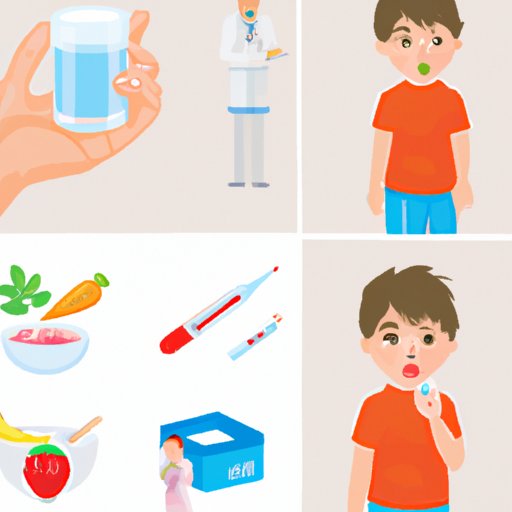
Introduction
A fever is a common symptom of an underlying illness that affects children of all ages. It is the body’s natural response to infections or other diseases and often occurs when the immune system detects a problem. It is important to break a fever fast to prevent it from getting worse and causing other complications. By doing so, parents can help their child recover quickly and reduce the risk of further medical issues. This article explores various ways of breaking a fever in children using natural remedies, hydration, medication, cooling techniques, and prevention.
Natural Remedies
Many natural remedies can help break a fever in children. These remedies can help treat the underlying illness and reduce fever symptoms. Examples include herbal teas, cool compress, and massage.
The use of herbal teas, such as chamomile tea or ginger tea, can help break a fever by promoting sweating, which helps regulate body temperature. Massage can also help reduce fever by improving blood flow and calming the nervous system. Applying a cool compress to the forehead or using a damp cloth can also help reduce fever by dissipating heat away from the body.
Hydration
Keeping children hydrated is crucial when they have a fever. Dehydration can worsen symptoms and make it harder for the body to regulate temperature. To increase fluid intake, children should be encouraged to drink water, broth, and electrolyte drinks.
In addition to increasing fluid intake, fluids also help regulate the body’s temperature by helping to dissipate heat. Therefore, fluids should be used to help regulate the body temperature of children with fevers.
Medication
There are many over-the-counter medications that can help reduce fever in children. These medications include acetaminophen and ibuprofen. When administering medicine, it is important to follow dosage instructions and take appropriate precautions.
Parents should be careful not to exceed the recommended dose of a medication and should avoid giving aspirin to children This is because aspirin has been linked to a rare but potentially fatal condition known as Reye’s syndrome. Parents should also make a note of the timing of the medicine to avoid giving doses too close together. If at all concerned, parents should consult a doctor before administering medication to children with fevers.
Cooling Techniques
Cooling techniques can also help break a fever in children. These techniques include using a fan or air conditioning and taking a cool bath.
Fan or air conditioning can help by increasing air circulation, allowing the body to dissipate heat more effectively. A cool bath works by lowering the body’s temperature rapidly, thereby breaking the fever quickly.
Prevention
Prevention is key when it comes to keeping children fever-free. Parents should encourage good hygiene practices, proper nutrition, and sufficient rest to keep their children healthy. Children should be encouraged to wash their hands frequently and to cover their mouths and noses when coughing or sneezing.
Parents should be mindful of the environment that their children are exposed to and take necessary precautions. These precautions may include avoiding contact with people who are sick and ensuring that their child’s living space is kept clean and hygienic.
Conclusion
Breaking a fever fast in a child is crucial to promoting a speedy recovery and preventing complications. Natural remedies, hydration, medication, cooling techniques, and prevention are all ways that parents can use to break a fever in their children. Parents should be mindful of their child’s symptoms and should consult a doctor if fever persists or other worrying symptoms appear.
By taking the necessary precautions, parents can keep their child fever-free and ensure that they stay healthy. Being prepared and informed is the key to fast and efficient fever treatment in children.





